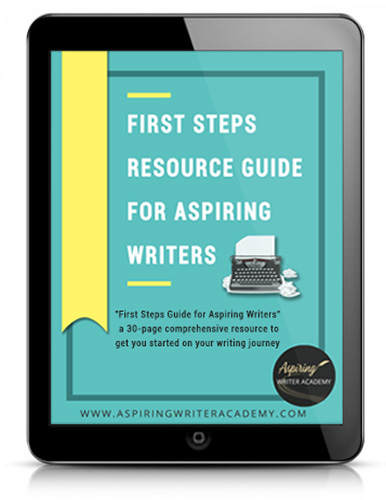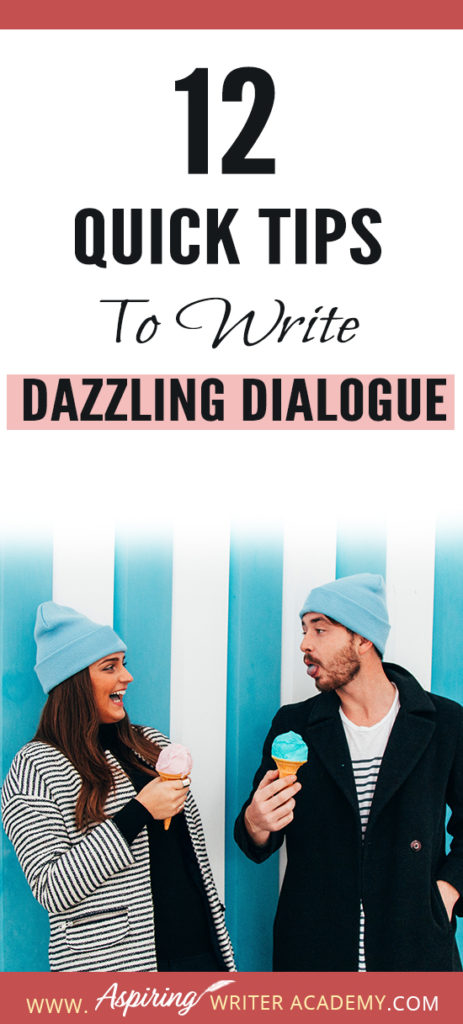12 Quick Tips to Write Dazzling Dialogue

Dialogue can be challenging to write. It takes time and practice to craft conversations that are believable, meaningful, serve to push the plot forward, and hold the attention of the reader. To help you improve your craft of fiction writing and make your character’s lines sparkle, we have created a list of 12 Quick Tips to Write Dazzling Dialogue.
1) Keep it simple.
- In most of today’s popular fiction genres there is no need for big fancy words or long run-on sentences of flowery prose.
- It is not necessary to include slang or regional dialect in every line.
- Avoid language that needs heavy explanation and do not have characters engage in dialogue just to give the reader an ‘information dump.’
- When a dialogue tag is necessary, simply use ‘he said’ or ‘she said’ to indicate who is speaking. Using too many tags like ‘he shouted’ or ‘she whispered’ or ‘he shrieked’ or ‘she bellowed’ can distract the reader.

2) Keep it focused.
Make sure that the characters in your story do not enter conversations without an intended purpose. If they just go around saying hello to everyone and chit-chatting about events, you risk boring the reader. Instead, you need conflict.
Before you write, ask:
- What does this character want or hope to achieve by talking to this other person?
- Does it move the plot forward? Or show insight into a character or situation?
- Who will oppose the one speaking?
- Will the conversation turn into a subtle disagreement or a full-blown verbal battle?
- Will one character say something to another that he did not expect?
- Or does the dialogue volley back and forth with playful banter?
Again ask—for what purpose? What does each character hope to get or achieve?
3) Employ Stimulus and Response.
If a character asks a question, the person he is talking to should answer. If one person makes a comment, the other should react. The secondary character should not start a new conversation thread without answering unless he is deliberately trying to avoid the subject.
In an argument, have them fight with their words, back and forth, like true opponents. One hits hard and then the other retaliates and hits back.
It is also important that you do not combine one character’s actions/reactions or thought in the same paragraph as another character’s dialogue. Keep it separate. And remember to start a new paragraph with each new speaker.

4) Delete obvious ‘on the nose’ dialogue.
If a character walks in and looks terrible, do not have the friend observing her directly say, “My, Lucy, you look terrible.” Instead have the friend say something funny or sarcastic to try to cheer her up. Or have the friend say the opposite of what she really thinks— “Wow! Lucy you look like a million bucks! Love your new hairstyle!”
Dull dialogue is dialogue one would expect, for example—
Bill: “Lucy, you look like you are freezing.”
Lucy: “I am freezing.”
Bill: “Do you want me to make a fire? A fire would keep us warm.”
Lucy: “I would love it if you made us a fire. Should I help collect sticks?”
Bill: “Yes, sticks would be great. We need kindling to get it started.”
Lucy: “Ok, I will go find some sticks.”
It is exactly what you would expect two characters in this situation to say.
To make your writing more exciting, rephrase the lines to give the reader what they would not expect. Make the dialogue fresh and interesting. Try to craft some zingers that make the reader chuckle. Have fun and play with it!
5) Use Subtext.
Make the dialogue work on two levels: what is being directly spoken and what is NOT.
Subtext is the layer beneath the words that might come out through body language, tone of voice, or redirection of words.
Example: Two people may be in a restaurant fighting over a bottle of ketchup. What is really going on here beneath the surface? One character may be mad at the other for showing up late and instead of confronting him about it, she uses the argument over ketchup to vent pent up emotions. The other character may engage in the ketchup argument to delay or avoid explaining why he was late.
Their conversation might go something like this:
Sally: “If it’s not too much trouble, can you pass the ketchup?”
Bob: “Just wait a minute, I’m almost done with it.”
Sally: “Why do you always expect me to wait for you?”
Bob pushes the ketchup toward her. “You want the ketchup? Here!”
Sally pushes the ketchup back. “No, by all means, take your time. That’s what you're good at.”
Bob avoids looking at her and mumbles: “There’s plenty of ketchup to go around. And if not, I’ll ask the waitress to bring another bottle.”
Sally: “Yeah, but the point is that you always serve yourself first. You aren’t considerate of others.”
Bob shakes his head. “Please! Take the ketchup. I don’t want it.”
Sally: “Too late. My food’s already cold.”

6) Consider differences in gender.
Generally, women talk more than men and they tend to be more emotional. Most men do not start sentences with ‘I’ or ‘We’ as women do. While women offer suggestions and ask questions, men typically make statements that are more factual, logical, straight to the point, and solution oriented.
7) Consider differences in age.
A five-year old will speak a lot differently than a ten-year old, teenager, adult, or grandparent. Make sure the words in their dialogue are consistent with their age group. People also speak differently to those in different age groups. So, you must also consider—who is this character speaking to? How would their words or tone change?

8) Differentiate each character’s voice.
In other words, do not make all of your characters sound the same. Each should have his own way of speaking to make him stand out from the rest even among his same gender or age group.
For example: One may have a lisp, one may use a favorite word or saying, another character may use a shrill tone when nervous or always cut off another person while they are in the middle of speaking. Someone else may gruffly bark orders, not knowing how else to speak.
Consider the background of the character; his education, the environment he grew up in, his unique personality. How would this affect the way he talks?
Example: an Australian crocodile hunter will most likely speak differently than a city cab driver, corporate CEO, or schoolteacher. Just as an avid sports fan may use active sports-related words to color his everyday speech.
Ask how you can use the character’s dialogue to show his personality, mood, or motivation for his actions. What makes this character unique?
9) Cut repetitions.
- Do you use the same word twice in one sentence?
- Do your characters repeatedly say the name of the person they are speaking to?
- Does a character tell another character something they should already know?
- Do you have two consecutive indented paragraphs that start with the same word?
- How many uses of the word ‘it’ do you have on the page? Circle them and you might be amazed. Try to replace ‘it’ with a word that is more specific.
- Read over each of your paragraphs and cut any unnecessary words that clog up the sentences, especially in the dialogue.
10) Look at punctuation.
Instead of reading the actual lines, just look at the punctuation symbols.
- How many exclamation points do you have on one page? Cut as many as you can and only keep the ones that are absolutely necessary. Many times, a simple period will work just fine.
- Also watch how many (…) you use.
- Do your questions that start with Who? What? Where? Why? How? have a question mark at the end instead of a period? (They should!)
- Are you missing any punctuation?
- Avoid capitalizing entire words or sentences to convey emotion.
- Also avoid using too many italicized words to emphasize emotion when you should instead consider using stronger words.

11) Let the dialogue stand out.
There is a common saying amongst editors— “Don’t bury the dialogue!” Look at your paragraphs.
- Is the dialogue stuck in the middle with other sentences both before and after? Instead, move the dialogue to one end of the paragraph or the other.
- Also highlight all sentences that are not dialogue. What do you see? Too much narrative, description, or introspection can clog a scene of dialogue making it hard for the reader to follow the conversation. Remove some of the excess for sharper dialogue, tension, and pacing within the scene.
- But you also want balance. Break up large blocks of dialogue that need a little fleshing out with action or descriptive narrative.
12) Read your work out loud.
You can read your work to yourself or another person. Many times, you will find mistakes that you didn’t see when writing.
- Does the dialogue sound like what real people would say? You want it to read realistic, but not too realistic—you may want to delete many of the “uh” and “ums.”
- Does anything sound awkward?
- Do you run out of breath before you can finish the sentence?
- Do you have any unintentional rhymes or tongue-twisters?
- Do the character’s names sound too similar or start with the same letter, thereby confusing the reader?
- Does the line you wrote suddenly sound silly when read aloud?
Thankfully, you can always revise.
If you are new to writing or are looking for some additional advice, we invite you to download our free First Steps Resource Guide for Aspiring Writers.
We hope you find the above 12 Quick Tips to Write Dazzling Dialogue useful while either writing your first draft or revising your finished manuscript. If you have any questions, comments, or other tips to add to this post, we would love to hear from you. You can leave a comment below or visit our website at: https://www.aspiringwriteracademy.com/contact/

ENTER YOUR EMAIL BELOW
TO GET YOUR FREE
"First Steps Guide for Aspiring Writers" a 30-page comprehensive resource to get you started on your writing journey.
Our Goal for Aspiring Writer Academy is to help people learn how to write quality fiction, teach them to publish and promote their work, and to give them the necessary tools to pursue a writing career.
If you have any questions or would like to leave a comment below, we would love to hear from you!
Other Blog Posts You May Like
Basic Story Structure: How to Plot in 6 Steps
Behind the Scenes: Interview with the Authors of the “Sew in Love” Collection
Our Inspiration For Writing A Historical Novella Collection
Brainstorming Story Ideas: Where to Find Them
Why We Started Aspiring Writer Academy: Our Story
Scene & Sequel: The Secret to Plotting an Epic Novel
Scene & Sequel: The Secret to Plotting an Epic Novel (Part 2)
Writing Fiction: How to Develop Your Story Premise
12 Quick Tips to Write Dazzling Dialogue
10 Questions to Ask When Creating Characters for Your Story
Macro Edits: Looking at Your Story as a Whole
Do you find it difficult to create compelling antagonists and villains for your stories? Do your villains feel cartoonish and unbelievable? Do they lack motivation or a specific game plan? Discover the secrets to crafting villains that will stick with your readers long after they finish your story, with our How to Create Antagonists & Villains Workbook.
This 32-page instructional workbook is packed with valuable fill-in-the-blank templates and practical advice to help you create memorable and effective antagonists and villains. Whether you're a seasoned writer or just starting out, this workbook will take your writing to the next level.

is a multi-published author, speaker, and writing coach. She writes sweet contemporary, inspirational, and historical romance and loves teaching aspiring writers how to write quality fiction. Read her inspiring story of how she published her first book and launched a successful writing career.




























I loved reading this post! I feel there aren’t enough that focus on the art of writing dialogue, but this post offers some really helpful advice for new writers. 😊 Even as a book editor at Stand Corrected Editing, polishing dialogue all the time, there are some things listed in your post that I hadn’t even considered!
Thank you for the nice compliments. We love getting feedback and are thrilled to hear that you find our content valuable.
I agree with the first commenter. I’m getting to be an “advice junkie” and trying to find more detailed help (like this). You have given me lots to review in my current manuscript. Thank you for this topic. I’m off to see what else you have stashed here.
Thank you for your thoughtful comment! I’m thrilled to hear that you found the post helpful and that it provided you with valuable insights for your manuscript. If you’re looking for more detailed advice and tips, I recommend signing up for our email newsletter. It’s a great way to stay updated with our latest writing tips and resources.
You can sign up here: https://www.aspiringwriteracademy.com/email-newsletter/
Happy writing, and I hope you find more useful content on the blog!